In the previous article I showed just how many of Hogarth’s characters from A Harlot’s Progress were standing at the correct Masonic stance – that is with your feet at a square.
This is mentioned many times throughout exposes and Masonic monitors.
Let us see how this concept continues into Hogarth’s second series – A Rake’s Progress (1734).
Observe this famous detail of the Rake carousing in the tavern. Even though it looks awkward, Hogarth still positions the character’s feet at the prescribed square.

Figure 1 – Rake’s feet at square with red lines
IMAGE CREDIT: William Hogarth – A Rake’s Progress (1734) Scene 1
In the first scene, the young rake is also at a square, and even though his father has passed away, the old miser’s discarded boots (which are sticking out of a box) are also standing in that same form.

Figure 2 – inserts showing feet and boots
IMAGE CREDIT: William Hogarth – A Rake’s Progress (1734) Scene 1
Another Masonic detail that is shared between these two scenes is the compass shape – such a tenant of Freemasonry.
In Scene 1 this is made by the old man’s crutches. In the tavern scene it is made by the Rake’s sword and sheath.
The symbolism of the compass ‘encompassing one’s passions’ was a popular Masonic phrase, and was always represented by the sign of the compass.
This message was so common that we see the design painted on a teapot.

Figure 3 – Crutches in Scene 1
IMAGE CREDIT: William Hogarth – A Rake’s Progress (1734) Scene 1
Hogarth incorporates this concept marvellously within his narrative.
The old man’s compasses (scene 1) do not open widely because he was a miser and did not enjoy his life to the full.
The compasses associated with the Rake (scene 3) are fully extended because the Rake lives vicariously.
It matches his wide spread legs (the original ‘manspreading’!)
Indeed, the rake’s compasses actually encloses several items that are symbolic of his wayward lifestyle – a smashed liquor glass, a box of syphilis pills and evidence that the Rake was in a fight with the night guard – all harbingers of his impending downfall.

Figure 4 – A Rake’s Progress (1734) Scene 3
IMAGE CREDIT: William Hogarth – A Rake’s Progress (1734) Scene 3
When we take a look at the full print we might notice another compass shape formed from the legs of the prostitute who is undressing for the Rake.
She will dance over the polished ‘posture tray’ that is being brought in by the man with the phallic candle and a huge bulge under his overcoat!
Between her legs we find the most curious and clever of all Hogarth’s Masonic inclusions.
She is pointing, with both hands, to a chicken which has been stabbed in the breast with a two pronged fork.
I include a line from an exposé of the time that will make you see the Masonic connection.
‘After one comes in at the door … the open compasses pointed to his breast.’
– The Mason’s Confession (1727)
You can imagine Hogarth wondering how he was going to represent these words with something that you might find in a Tavern.
What else pricks a naked breast like a compass? Hogarth’s solution was to draw a two-tined fork stabbed into the left breast of a chicken.
This one detail has generated so much commentary over the years. For centuries, millions have been disgusted by the image of a whole uneaten chicken sitting in a pool of effluent unaware of its brilliant Masonic message.

Figure 5 – Chicken and chamber pot G.
IMAGE CREDIT: William Hogarth – A Rake’s Progress (1734) Scene 3
The chamber pot in question is another brilliantly concealed Masonic symbol – the letter ‘G’ (for Geometry).
Notice how the handle has been manipulated to form the lower part of the letter.
The flow of urine has not been drawn in at the top of the pot (note my red circle).
A liquid could not flow in this manner, but it makes the letter more recognizable, and is proof of Hogarth’s intentions.
The reason that Hogarth featured the most revered of all symbols in this disrespectful fashion takes me a whole book to explain – William Hogarth – A Freemasons Harlot, 2017.
With these few details, I hope you get the picture that Hogarth’ second series was just as Masonic as his first.
While A Harlot Reveals All, the Rake has certainly Exposed Himself!
In next month’s final article post (#12), I will give a glimpse of the many other Masonic details within these two series.
If this article was called A Harlot Reveals All the next would be A Rake Exposes Himself!
I cover all the scenes in my upcoming eBook which will expand upon these lectures and show many more Masonic symbolism within these prints.
Plus, I will show how Hogarth continued this love of Masonic symbolism right through his career.
Artist: William Hogarth (1697-1764)
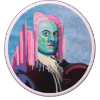
William Hogarth was made a Mason at the Hand and Apple Tree Lodge in Little Queen Street, Holborn, London c1725-28.
He later joined the Bear and Harrow in Butcher Row, known later as the ‘Corner Stone’ Lodge 4, and then Grand Steward’s Lodge. He designed a jewel known as ‘Hogarth’s Jewel’, it remained in continual use into the nineteenth century.
Hogarth was a prolific English painter whose scenes often demonstrated a satirical depiction of 18th century life.
He was responsible for the Copyright Act passed by Parliament in 1735 also known as the Hogarth Act.
Artwork: Tim Fowler
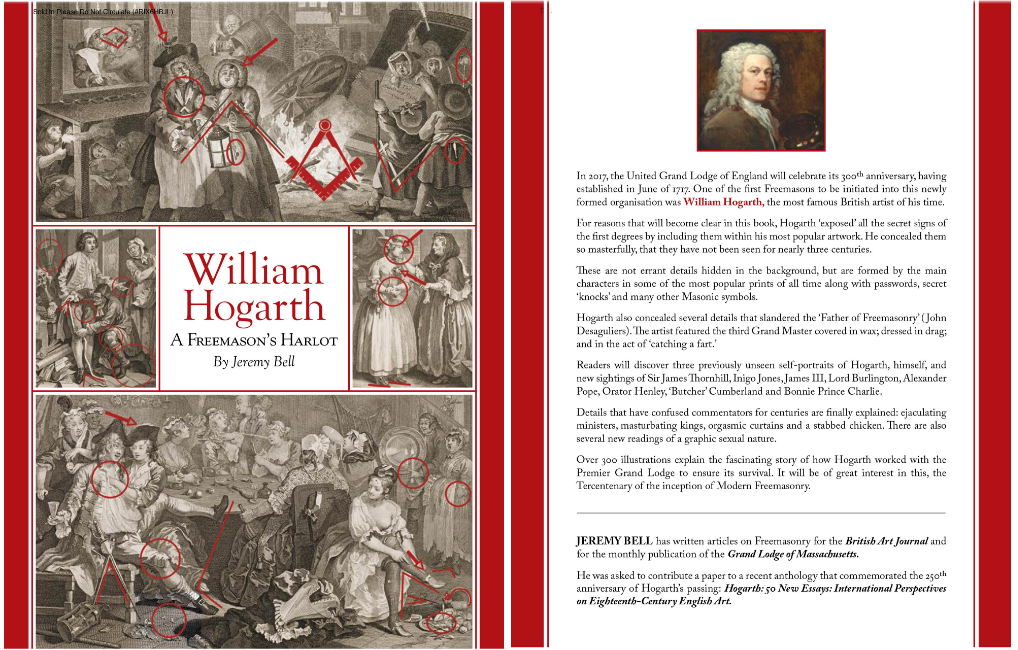
Many more details from the other scenes are explained in my book William Hogarth - A Freemason’s Harlot which is available from my website www.brotherhogarth.com.
Email me at Brotherhogarth@gmail.com. I can show you how many of Hogarth’s other works were Masonically themed.
Recent Articles: by Brother Hogarth
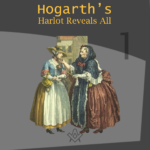 Hogarth’s Harlot Reveals All - Part 1 A new series looking at the hidden Masonic symbolism within Brother Hogarth's works - what can you find? |
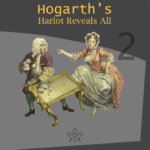 Hogarth’s Harlot Reveals All - Part 2 The second instalment in the series looking at the hidden Masonic symbolism within Brother Hogarth's works - what can you find? |
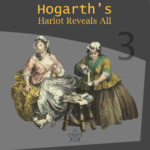 Hogarth’s Harlot Reveals All - Part 3 Brother Hogarth gives us another bawdy glimpse into the salacious world of the 'Harlot's Progress', and the tantalising Masonic symbolism hidden within! Can you spot the clues? |
 Hogarth’s Harlot Reveals All - Part 4 This month we find her in prison doing forced labour. So why, you may ask, is she dressed so finely? This sudden change of costume confused many commentators over the centuries. |
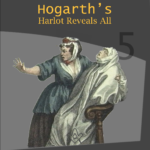 Hogarth’s Harlot Reveals All - Part 5 In last month’s instalment, our Harlot is found in prison doing forced labour. In this instalment the Harlot dies! |
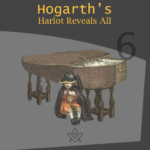 Hogarth’s Harlot Reveals All - Part 6 With our protagonist (the Harlot) lying in her casket, what next for the Widow's Son? |
 Hogarth's Harlot Reveals All - Part 6.2 A naughty clergyman, the virgin, and 'Father Time' - what can Hogarth reveal now?! |
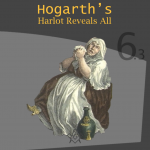 Hogarth's Harlot Reveals All - Part 6.3 Who are the famous men featured in the scene? Hogarth reveals all! |
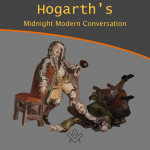 Hogarth's Midnight Modern Conversation Brother Hogarth is back with a look at another work of art with Masonic symbolism 'hidden in plain view' - what is occurring within the Midnight Modern Conversation? |
 Hogarth discreetly embeds more masonic signs and symbols in his paintings , never forgetting, everything he included in his scenes had meaning and is there for a reason. |
 Hogarth discreetly embeds more masonic signs and symbols in A Rake’s Progress, never forgetting, everything he included in his scenes had meaning and is there for a reason. |
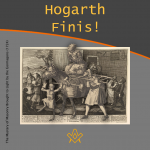 For twelve months Hogarth and his Harlot have revealed all, and the Rake has exposed himself. In this, the last part of the series (for now), we get a final glimpse at a few more of Hogarth's Masonic 'reveals'. |
masonic knowledge
to be a better citizen of the world
share the square with two brothers

click image to open email app on mobile device







